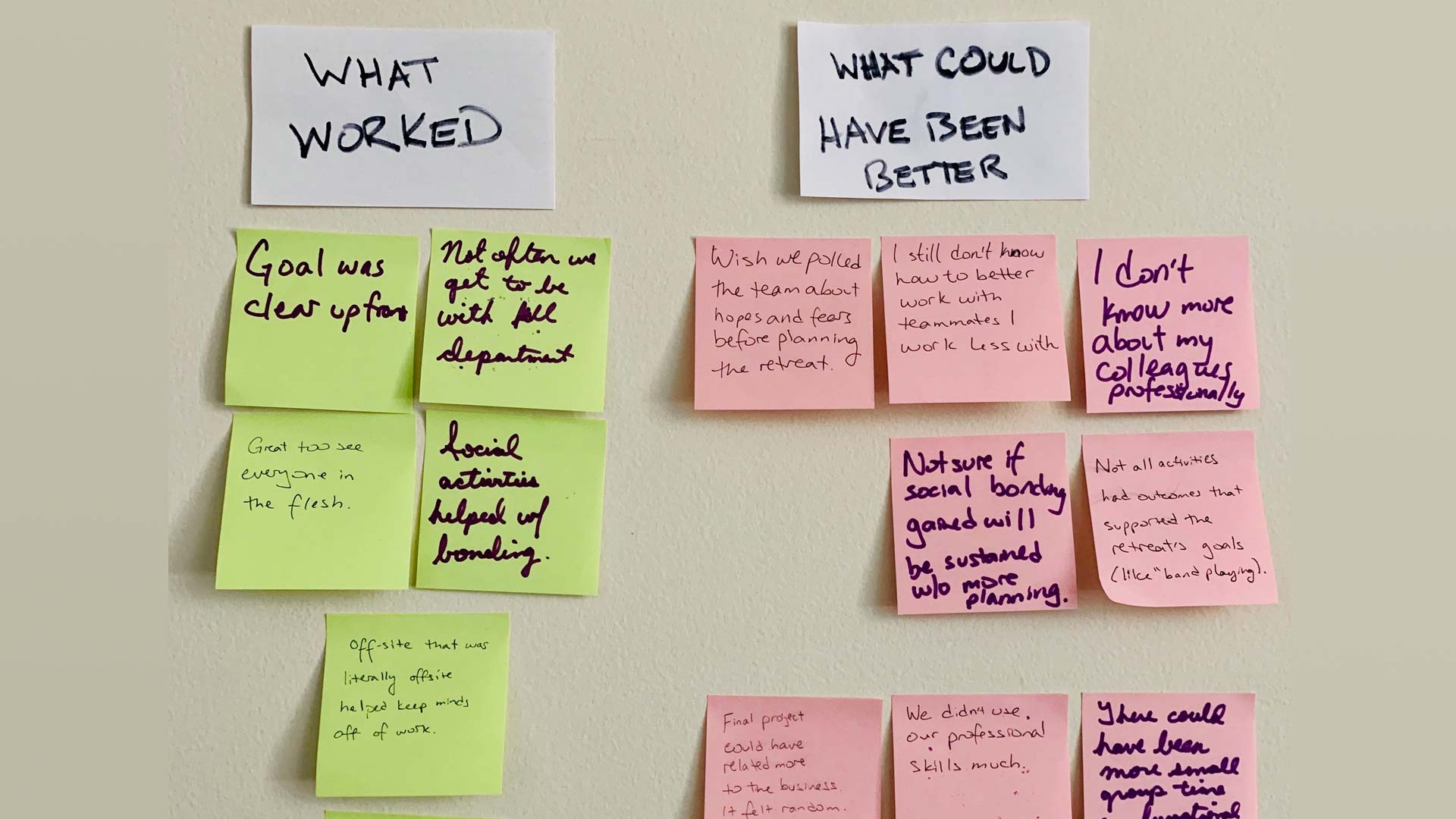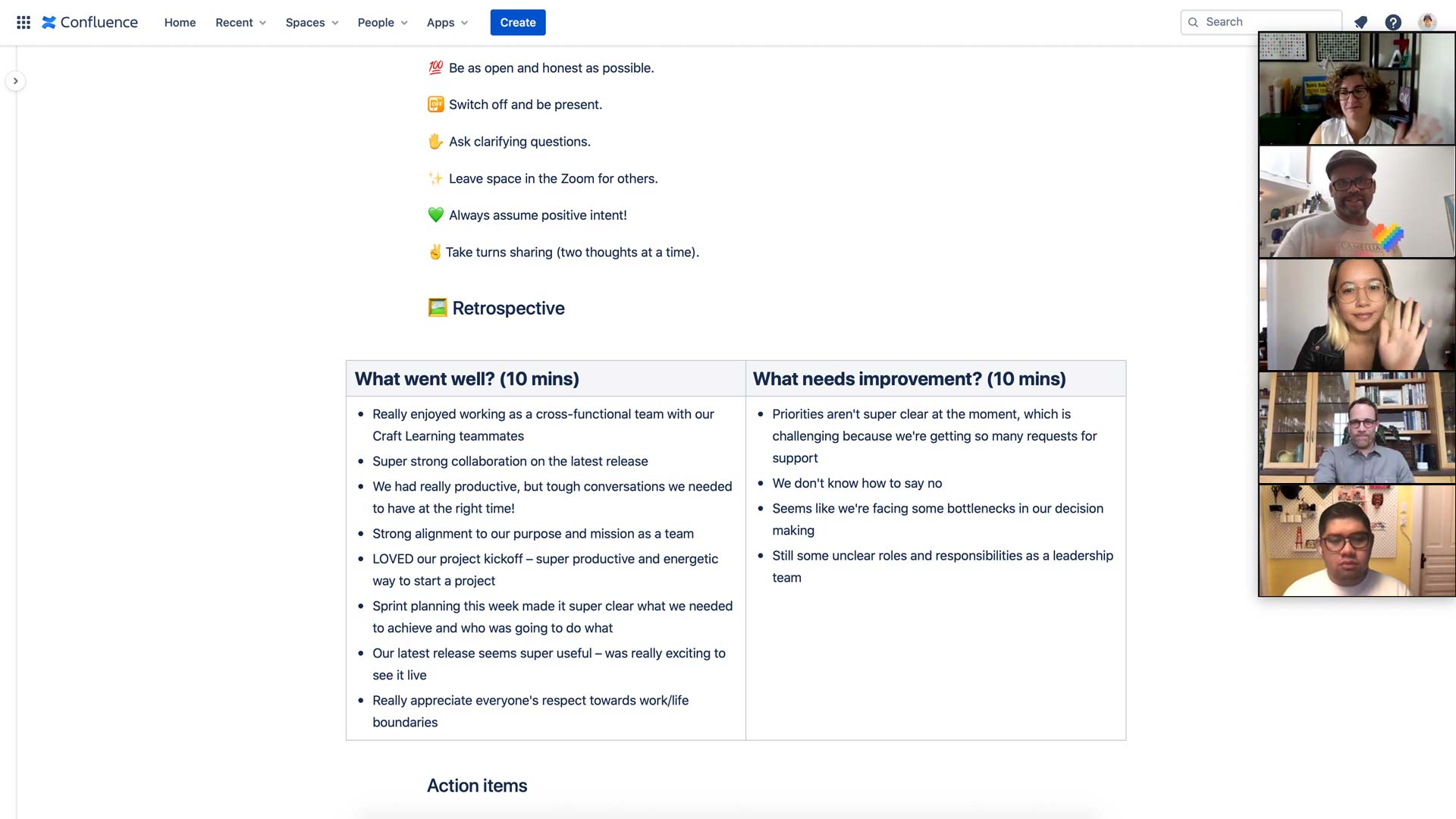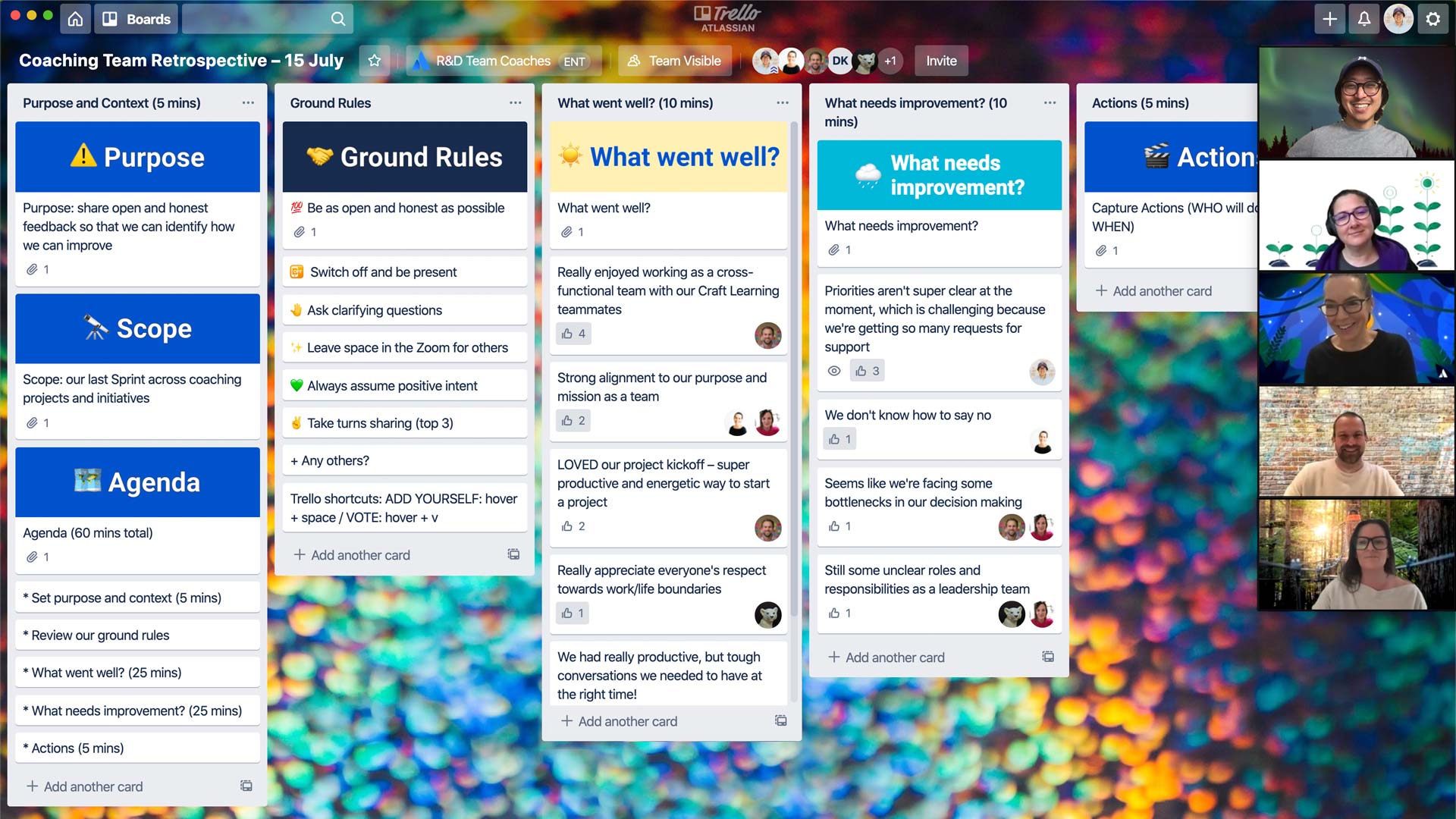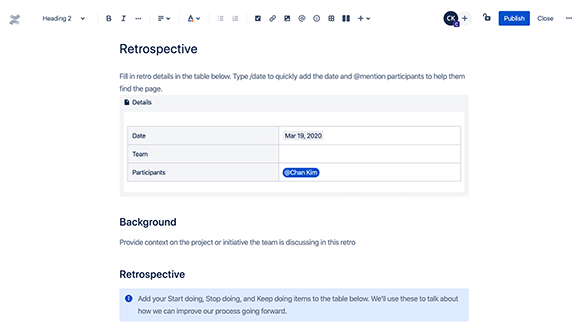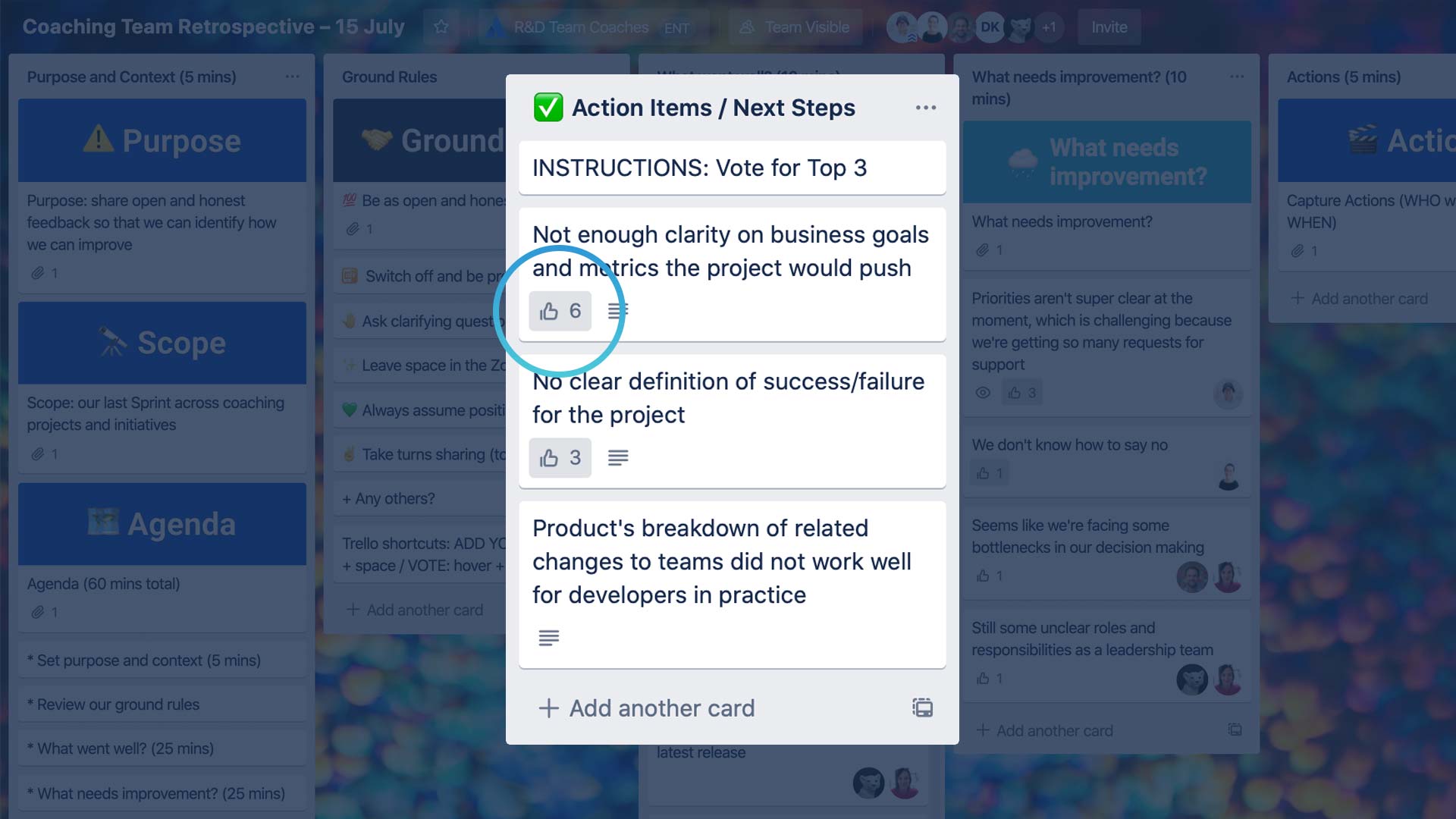Retrospektywy sprintu
Retrospektywa sprintu umożliwia przegląd ostatniego sprintu i wprowadzenie ulepszeń do przyszłych sprintów. Te spotkania są niezbędne, gdyż regularna ocena i doskonalenie procesów skutkuje wysokiej jakości wynikami i mniejszą liczbą przeszkód.
W tym przewodniku wyjaśnimy, czym jest retrospektywa sprintu, dlaczego jest ważna i jak przeprowadzać udane przeglądy sprintów, aby poprawić efektywność zespołu.
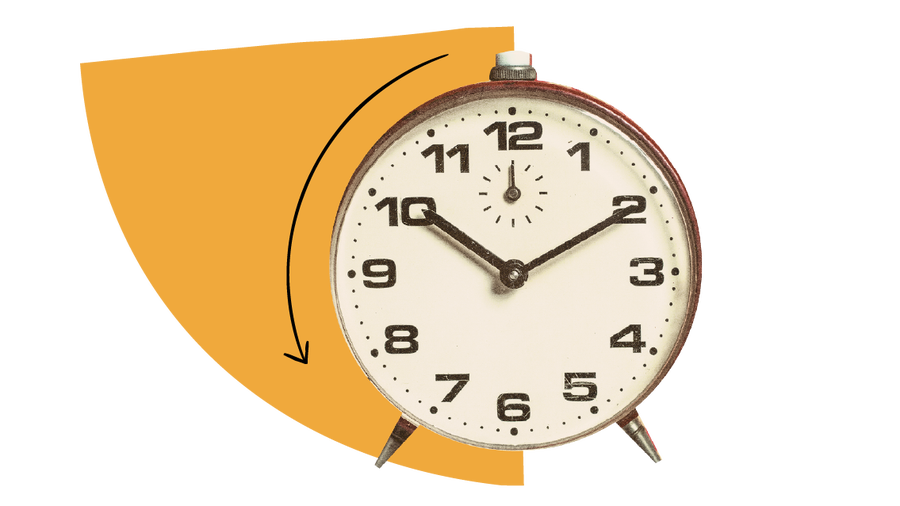
Przygotowanie
15 min
Czas trwania
60 min
Osoby
4–8
5–SEKUNDOWE PODSUMOWANIE
- Uczcij to, co poszło dobrze podczas ostatniego sprintu.
- Porozmawiaj o tym, co nie poszło tak dobrze lub mogło pójść lepiej.
- Określ, jak wprowadzić ulepszenia w następnym sprincie.
- Wykorzystaj sztuczną inteligencję do podsumowania analizy, wyciągnięcia wniosków i ułatwienia ich wdrożenia.
POTRZEBNE ELEMENTY
- Sala konferencyjna lub wideokonferencje z możliwością udostępniania ekranu.
- Narzędzie do współpracy cyfrowej (zobacz szablony)
- Opcjonalnie: fizyczna tablica, markery, karteczki samoprzylepne i zegar
Jak przeprowadzić retrospektywę sprintu
Zastanów się nad wcześniejszymi sprintami, aby wprowadzić ulepszenia na przyszłość.
Czym jest retrospektywa sprintu?
Retrospektywa sprintu to przegląd przeprowadzany po ukończeniu sprintu, który jest jednym z kluczowych elementów metodyki Agile. Zadaniem retrospektywy sprintu jest ustalenie, co się udało, a gdzie wystąpiły problemy, oraz zidentyfikowanie obszarów wymagających poprawy.
Regularne przeglądy są nieodzownym elementem współpracy zespołowej. Dzięki ustaleniu, co działa, a co nie, możesz ulepszyć procesy Agile i tym samym uprościć kolejny sprint.
A dzięki sztucznej inteligencji, która pomaga znaleźć dokumentację ze sprintu, podsumować wnioski i wygenerować praktyczne kroki, retrospektywy sprintów są jeszcze bardziej wartościowe.
Kto powinien brać udział w spotkaniu dotyczącym retrospektywy sprintu?
Na spotkaniu dotyczącym retrospektywy sprintu powinien być obecny product owner, zespół Scrum, Scrum Master, interesariusze i Rovo.
Dobrze jest, jeśli uczestnicy spotkania wnoszą różne punkty widzenia. Mogą wspólnie przeanalizować ostatni sprint i określić, jakie zmiany trzeba wprowadzić przed rozpoczęciem kolejnej części projektu.
Jak często należy przeprowadzać retrospektywy sprintów?
Retrospektywy najlepiej sprawdzają się pod koniec każdego sprintu. Jednak jeśli Twoje sprinty są krótkie (np. trwają tydzień), więcej sensu może mieć przeprowadzanie retrospektywy po co drugim sprincie.
Jak długo powinny trwać retrospektywy sprintów?
Czas trwania spotkania retrospektywnego może się różnić w zależności od czasu trwania sprintu. Mogą trwać zaledwie 45 minut lub nawet 3 godziny. Daj zespołowi dość czasu i przestrzeni na konstruktywną rozmowę. Zaplanowanie dodatkowego czasu pomaga zaoszczędzić czas i poprawić wyniki w dłuższej perspektywie.
Jakie są główne zalety retrospektyw sprintów?
Retrospektywy sprintów pomagają zespołowi wyciągać wnioski z przeszłości i doskonalić się w przyszłości, prowadząc do usprawnienia sprintów Scrum i lepszego wyniku końcowego.
Badania pokazują, że główne zalety retrospektyw polegają na tym, że pomagają one zespołowi zrealizować następujące cele:
- Osiągnięcie ciągłego doskonalenia
Opracowanie planu działania i jego weryfikacja na kolejnych spotkaniach ma kluczowe znaczenie dla rozwoju. - Poprawa refleksyjności zespołu
Refleksyjność to „stopień, w jakim członkowie zespołu wspólnie zastanawiają się nad celami, strategiami i procesami zespołu, oraz dostosowują je do obecnych lub przewidywanych okoliczności”.
Zespół o wyższym poziomie refleksyjności często lepiej wprowadza innowacje, identyfikuje problemy i możliwości, dostosowuje się do zmian i skutecznie wdraża nowe pomysły.
Wyższa refleksyjność to zwykle także:
- Podejmowanie lepszych decyzji
- Lepsze rozwiązywanie problemów
- Skuteczniejsze wdrażanie strategii
- Szybsze uczenie się zespołu
- Więcej innowacji
-
Większa zdolność adaptacji do zmian
Inne badania potwierdzają, że refleksyjność pomaga zespołom:
- dokładniej przetwarzać informacje;
- ograniczać liczbę błędów i niepowodzeń;
- zwiększać elastyczność w przypadku pojawienia się zmian.
Pomysły na spotkania retrospektywne
Retrospektywy sprintu mogą początkowo wydawać się przytłaczające, ale są dość proste w realizacji. Możesz użyć szablonu retrospektywy lub wykonać pięć kroków wskazanych powyżej. Dopóki otrzymujesz oczekiwane informacje zwrotne oraz wykorzystujesz je do generowania analiz i wdrażania zmian, robisz to dobrze.
Punktem wyjścia każdej retrospektywy sprintu jest udany sprint. Jira oferuje kilka kluczowych funkcji, które pomagają w organizacji udanych sprintów, w tym:
- Backlogi: Backlogi umożliwiają wyszczególnienie wszystkich prac związanych z danym projektem czy inicjatywą. Zakres prac można podzielić na poszczególne sprinty, które zazwyczaj trwają ok. 2 tygodni.
- Tablice: Tablice Jira pozwalają podzielić duży projekt na łatwiejsze do zarządzania części, co usprawnia planowanie sprintów i zapewnia szybsze dostarczanie produktów.
- Osie czasu: Osie czasu pozwalają zsynchronizować zespół z interesariuszami, zapewniając wgląd w oś czasu projektu z wszystkimi zmapowanymi elementami pracy, zależnościami i wydaniami.
Jira ułatwia zespołom Agile wizualizację, śledzenie i zarządzanie sprintami. Za pomocą oprogramowania Jira usprawnisz swój kolejny sprint, aby zapewnić terminowe dostarczenie rezultatów. Wypróbuj tablice Scrum Jira i przekonaj się, w jaki sposób narzędzie to pozwala zoptymalizować pracę zespołów Agile.
Retrospektywa sprintu — często zadawane pytania
1. Określenie założeń początkowych
Szac. czas: 5 MIN
Retrospektywy są częścią procesu planowania sprintu. Celem jest zebranie różnorodnych informacji zwrotnych i punktów widzenia w celu poprawy procesów i wyników. Skorzystaj z jednego z naszych gotowych szablonów, który ułatwi proces.
Na początku spotkania zachęć uczestników, aby podczas sesji z szacunkiem dzielili się swoimi szczerymi przemyśleniami, koncentrując się na poprawie, a nie obwinianiu się. (Jest to klucz do stworzenia poczucia bezpieczeństwa i kultury niewskazywania winnych). Aby pomóc, dodaj Loom AI do swojego spotkania, aby rejestrować notatki, dzięki czemu Twój zespół będzie mógł skupić się na samym podsumowaniu.
Na koniec zachęć swój zespół, aby rozmawiał z Rovo jako partnerem do dyskusji, jeśli ma jakiekolwiek obawy dotyczące tonu lub treści informacji zwrotnej.
Wskazówka: Stwórz bezpieczną przestrzeń
Wyjaśnij, co się stanie z informacjami omawianymi podczas retrospektywy. Czy pozostaną w grupie? Czy zostaną przekazane kierownictwu? Rozważ przyjęcie reguły Chatham House, aby pomóc członkom zespołu poczuć się bezpiecznie i komfortowo.
2. Zebranie informacji zwrotnej
Szac. czas: 15 MIN
Po określeniu założeń początkowych i oczekiwań dotyczących spotkania możesz zebrać opinie członków zespołu na temat tego, jak przebiegł ostatni sprint. Jest na to wiele sposobów, w tym:
- 💬 Otwarta dyskusja grupowa na temat tego, co poszło dobrze, a co nie
- 🗒️ Ankiety (anonimowe lub imienne)
- ❤️ Retrospektywa 4L: omów to, co wszyscy polubili, znienawidzili, czego się nauczyli oraz za czym tęsknili podczas ostatniego sprintu.
- 🙂 Metoda „Zadowolenie, smutek, złość”: omów, co sprawiło, że członkowie zespołu poczuli każdą z tych emocji. Co było rozczarowujące? Frustrujące? Ekscytujące i zachęcające?
- Użyj wyszukiwania Rovo, aby zebrać odpowiednie strony lub zgłoszenia, które pomogą Ci umieścić opinię w odpowiednim kontekście.
Porada: skłoń uczestników do zabierania głosu
Jedną z największych przeszkód w retrospektywie sprintu jest to, że członkowie zespołu nie dostarczają wystarczającej informacji zwrotnej. Poza stworzeniem bezpiecznej przestrzeni spróbuj poprowadzić rozmowę z wykorzystaniem prostej struktury, takiej jak retrospektywa 4L lub metoda „Zadowolenie, smutek, złość”. Możesz też spróbować zebrać informacje anonimowo.
Jeśli ktoś zdominuje rozmowę, poproś inne osoby o podzielenie się przemyśleniami, aby upewnić się, że każda zabierze głos.
3. Przekształcenie informacji zwrotnej w analizy
Szac. czas: 20 min
Jako grupa poszukajcie wzorców i trendów w informacji zwrotnej. Czego się dowiedzieliśmy? Jakie zmiany możemy wprowadzić, aby oprzeć się na tym, co dobre, oraz ograniczyć lub wyeliminować to, co złe? Te analizy są kluczem do ustalenia celów i wprowadzenia ulepszeń, dlatego zachęcaj wszystkich do wnoszenia dowolnego wkładu.
Porada: obserwuj trendy
W retrospektywach sprintów chodzi o ulepszenie następnego sprintu, dlatego skup się bardziej na wzorcach i trendach, a nie jednorazowych błędach lub sukcesach, które prawdopodobnie się nie powtórzą.
Wskazówka: Dodaj Rovo do grupy
Wykorzystaj czat Rovo, aby wyodrębnić z opinii kluczowe wzorce i trendy.
4. Określenie czynności do wykonania
Szac. czas: 15 min
Teraz pora na przekształcenie analiz w działanie. W tym miejscu możesz zacząć wyznaczać cele i określić, jakie zmiany będzie trzeba wprowadzić w kolejnych sprintach.
Podczas dokumentowania zmian i czynności do wykonania pamiętaj o przypisaniu właścicieli i terminów, aby przyspieszyć postępy.
Porada: dodaj czynności do wykonania do swojej listy zadań
Zamiast lub oprócz spisania czynności do wykonania na karteczce samoprzylepnej lub w cyfrowym dokumencie, wprowadź je bezpośrednio do swojego systemu planowania sprintu lub zarządzania projektami, takiego jak Jira lub Trello, aby uwzględnić je w swoich planach.
Jeśli którakolwiek z czynności do wykonania ma odpowiadające jej zgłoszenia, umieść te łącza na stronie retrospektywy i/lub w zadaniach, aby łatwo było zobaczyć status.
Wskazówka: Skorzystaj z czatu AI
Przekształć opinie, wzorce i analizy w praktyczne działania dzięki czatowi AI.
5. Zakończenie
Szac. czas: 5 min
Zakończ swoją retrospektywę sprintu, dziękując wszystkim za ich wkład i przedstawiając podsumowanie kluczowych wniosków i czynności do wykonania. A teraz pora na kolejny sprint!
Różnice
Nie dopuszczaj do tego, aby Twoje retrospektywy stały się nieaktualne, jak ćwiczenia do odbębnienia, które są bezcelowe. Istnieje wiele sposobów zachęcania do rozmowy, więc eksperymentuj i zobacz, co najlepiej sprawdza się w Twojej grupie. Oto dziewięć naszych ulubionych ćwiczeń dotyczących retrospektywy sprintu.

Ciągle masz pytania?
Rozpocznij rozmowę z innymi użytkownikami Porad strategicznych dla zespołów Atlassian, uzyskaj wsparcie lub przekaż informacje zwrotne.
Inne gry, które mogą Ci się spodobać
SPOTKANIA
Cotygodniowe aktualizacje dotyczące zespołu
Informuj, jak się sprawy mają — bez planowania kolejnego spotkania.
SPOTKANIA
Spotkania prowadzone na podstawie strony
Punktem wyjścia do organizowania lepszych spotkań jest strona, która przedstawia cel, oczekiwane wyniki i najważniejsze punkty dyskusji.
Komunikacja
Instrukcja użytkownika
Pomóż pozostałym członkom poznać styl Twojej pracy.
Kultura
Health Monitor dla zespołu
Oceń kondycję zespołu i przygotuj plan ulepszeń.
Zawsze aktualne informacje
Po zapisaniu się do naszego newslettera będziesz otrzymywać aktualne porady dotyczące gier i życia zawodowego.







